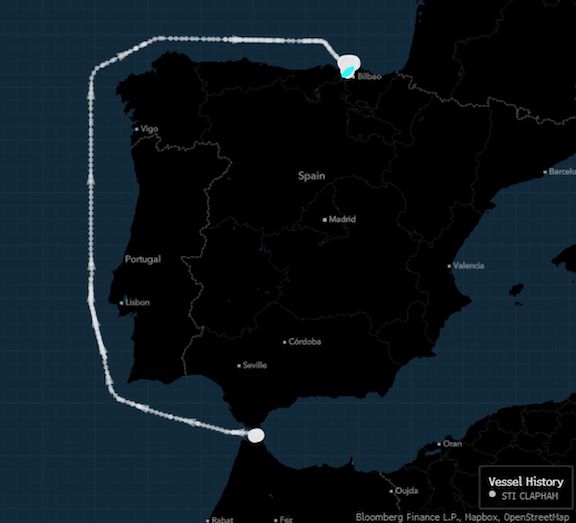A shipment of diesel at the center of a European Union sanctions-busting claim had an inconsistency in its paperwork.
Spain’s biggest oil refiner, Repsol SA, said on April 27 that Russian diesel has been entering the country in breach of EU sanctions. While the company didn’t name any tankers bringing in the fuel, at least one of them is the STI Clapham, according to a person familiar with the matter.
In early March, the STI Clapham loaded about 225,000 barrels of diesel at the Moroccan port of Tangier, according to paperwork seen by Bloomberg. It then sailed north, eventually discharging the fuel, after some delay, into the Spanish port of Bilbao.
The cargo’s Certificate of Origin, seen by Bloomberg, says that the fuel on the STI Clapham came from Saudi Arabia. Specifically, it was part of a consignment that had previously been delivered into the Moroccan port by another vessel called the Minerva Pisces, according to a person familiar with additional paperwork.

However, documents relating to the STI Clapham’s shipment show that the fuel it loaded in Morocco wasn’t the same density as the Minerva Pisces had earlier delivered — a small but potentially important discrepancy. It suggests the fuel delivered to Spain wasn’t what the Minerva Pisces collected from Saudi Arabia.
Cameron Mackey, chief operating officer at Scorpio Tankers Inc., the STI Clapham’s owner, said the company was looking into the matter.
“All procedures were followed, and all documentation was in order,” he said. “Nonetheless, we are investigating whether there’s any possibility that we were the victims of fraud.”
Spanish newspaper El Mundo named the STI Clapham last week, without saying where it got the information.
Two documents seen by Bloomberg show the density of the STI Clapham’s diesel cargo was 0.8330 or 0.8319 metric tons per cubic meter, depending on how it’s calculated. A third put it at 0.8334. However, a fourth document pertaining to the Minerva Pisces showed that consignment’s density was notably different, at 0.8197 tons per cubic meter.
The relative density — specific gravity — of diesel is typically measured to four decimal places, according to Steve Sawyer, director of refining at FGE, a consulting firm. Even a difference of 0.01 is significant and could be enough to differentiate between two cargoes as long as the product sampling and testing procedures were correct and robust, he said. He was speaking in general terms.
“For every one of our voyages, our manager conducts due diligence on the legitimacy and legality of the trade. Moreover, this particular voyage of the STI Clapham was subject to the oversight and scrutiny of Spanish customs and port state control,” Scorpio’s Mackey said.









